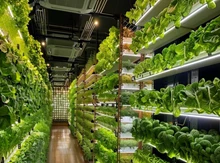
Ever since India gained independence several decades ago, land fragmentation has been a persistent issue with the size of the land decreasing with each successive generation, majorly due to the inheritance laws. The laws deem that the land owned by parents will be inherited by their children and is to be divided into fragments. And, India, as we know, is an agrarian economy with agriculture contributing to over 58% of employment in the country as of 2018. However, fragmented land poses a major challenge.
Eventually, over generations, this kind of fragmented land becomes unviable for agriculture as the yield significantly reduces as compared to the resources and investment required to cultivate produce. Particularly in densely populated areas that have a majority of people involved in agriculture the issue of small landholdings is rampant with the average area of land alarmingly low. Approximately, India’s average agricultural landholding is 1 hectare, making scaling nearly impossible simply due to the aforementioned factors such as population and those involved in agriculture. On that note, let’s delve deeper into understanding and resolving India’s land fragmentation issue.
The legal snags: Conflicting narratives and land laws
Initially, after India gained independence, to address the challenges posed by the colonial rule and the zamindari system, the country came up with legislation in a bid to help farmers, but eventually, this proved to do more harm than good. The problem is three-fold. Firstly, state governments prohibited non-farmers to buy farm land to protect farmers from losing their land to businessmen at fire-sale prices due to a bad harvest season. However, in an unexpected turn of events, this drastically reduced the number of potential buyers, thereby decreasing land prices besides leading to further land fragmentation due to the separation of agricultural land from other lands.

Secondly, nearly every state regulated the maximum landholding to eradicate the zamindari system. However, over time, as mentioned earlier, India’s agricultural land has been fragmented due to the division of inherited property that in turn trapped farmers with smallholdings that neither could prove useful for sufficient agriculture nor could be scaled. Lastly, there were income restrictions imposed on non-agricultural income to prevent the rich zamindari families from acquiring land and exploiting farmers rendered helpless by financial crunches.
However, this pushed richer agricultural families from the agricultural land market to other opportunities. Over the years, the income limits have been raised by state governments but low productivity due to fragmentation only decreases land prices. Now, a million-dollar question arises; How can we address this problem, and what role does agri-tech play?
FPOs as an aggregation point to make farming remunerative for farmers
Many of the farmers have started becoming part of FPOs. Government has also been encouraging creation of FPOs. FPOs are an effective mechanism to help improve the challenges arising out of land fragmentation. The land ownership is individual however the production parameters are across a mass of farmers who form the FPOs. Many agri-tech companies are working together with the FPOs to help resolve this. FPOs are a good institutional mechanism and agri tech companies help in digitising them and bringing in the benefits of aggregation to the farmers.
Resolving the issue and the role of agri-tech
Agri-tech in India, although not an entirely new concept, has begun to gain rapid traction only over the past few years. Committed to addressing various problems such as the farm-to-fork issues that prevail across the country, converting unproductive landholdings into productive ones, increasing farmers’ average income, helping them procure farm inputs, and even availing credit, agri-tech startups have been a game-changer for the country’s agricultural problems. According to NASSCOM, as of 2019, India had more than 450 agri-tech startups. Now, driven by the COVID-19 pandemic and large-scale market reforms, agri-tech startups are aggressively ramping up their digital infrastructure further to create seamless farm-to-fork services and in turn address the land fragmentation issue that prevails.
With a data-driven approach powered by cutting-edge technologies, agri-tech startups are empowering farmers to up their yield within their land by offering them guidance on what crops to grow and which season to grow them in, pricing, demand and supply patterns, purchasing farm inputs, and gaining access to credit. With the pandemic reiterating how sustainable agricultural plans are of utmost importance, agri-tech startups, along with state and central governments reforming laws, are on a mission to equip India’s agricultural sector to revive itself and better prepare for future crises, if any.
Also, Agri-tech start-up’s help in aggregating the demand of various agri inputs which helps them provide better value to even a smallholder farmer. Similarly, on the output side a number of agri tech startups have been working on aggregating the output from small holder farmers and selling directly to the food processors.
Conclusion
India’s farm-to-fork supply remains one of the most fragmented in the world along with the fragmentation of land. However, with continued efforts from government and private bodies in resolving the land fragmentation issue, firstly through reformed regulations and secondly, through various interventions by agri-tech firms and other private players will help in improving agriculture output. Resolving the problems arising out of land fragmentation is very critical to create a thriving agricultural sector in India.













Share your comments